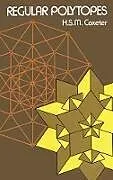H. S. M. Coxeter: Through the Looking Glass
Harold Scott MacDonald Coxeter (1907?2003) is one of the greatest geometers of the last century, or of any century, for that matter. Coxeter was associated with the University of Toronto for sixty years, the author of twelve books regarded as classics in their field, a student of Hermann Weyl in the 1930s, and a colleague of the intriguing Dutch artist and printmaker Maurits Escher in the 1950s.
In the Author's Own Words:
"I'm a Platonist ? a follower of Plato ? who believes that one didn't invent these sorts of things, that one discovers them. In a sense, all these mathematical facts are right there waiting to be discovered."
"In our times, geometers are still exploring those new Wonderlands, partly for the sake of their applications to cosmology and other branches of science, but much more for the sheer joy of passing through the looking glass into a land where the familiar lines, planes, triangles, circles, and spheres are seen to behave in strange but precisely determined ways."
"Geometry is perhaps the most elementary of the sciences that enable man, by purely intellectual processes, to make predictions (based on observation) about the physical world. The power of geometry, in the sense of accuracy and utility of these deductions, is impressive, and has been a powerful motivation for the study of logic in geometry."
"Let us revisit Euclid. Let us discover for ourselves a few of the newer results. Perhaps we may be able to recapture some of the wonder and awe that our first contact with geometry aroused." ? H. S. M. Coxeter
Klappentext
Professor Coxeter begins with the fundamental concepts of plane and solid geometry and then moves on to multi-dimensionality. Among the many subjects covered are Euler's formula, rotation groups, star-polyhedra, truncation, forms, vectors, coordinates, kaleidoscopes, Petrie polygons, sections and projections, and star-polytopes. Each chapter ends with a historical summary showing when and how the information contained therein was discovered. Numerous figures and examples and the author's lucid explanations also help to make the text readily comprehensible.
Inhalt
I. POLYGONS AND POLYHEDRA
1Regular polygons
1Polyhedra
1The five Platonic Solids
1Graphs and maps
1"A voyage round the world"
1Euler's Formula
1Regular maps
1Configurations
1Historical remarks
II. REGULAR AND QUASI-REGULAR SOLIDS
2Regular polyhedra
2Reciprocation
2Quasi-regular polyhedra
2Radii and angles
2Descartes' Formula
2Petrie polygons
2The rhombic dodecahedron and triacontahedron
2Zonohedra
2Historical remarks
III. ROTATION GROUPS
3Congruent transformations
3Transformations in general
3Groups
3Symmetry opperations
3The polyhedral groups
3The five regular compounds
3Coordinates for the vertices of the regular and quasi-regular solids
3The complete enumeration of finite rotation groups
3Historical remarks
IV. TESSELLATIONS AND HONEYCOMBS
4The three regular tessellations
4The quasi-regular and rhombic tessellations
4Rotation groups in two dimensions
4Coordinates for the vertices
4Lines of symmetry
4Space filled with cubes
4Other honeycombs
4Proportional numbers of elements
4Historical remarks
V. THE KALEIDOSCOPE
5"Reflections in one or two planes, or lines, or points"
5Reflections in three or four lines
5The fundamental region and generating relations
5Reflections in three concurrent planes
5"Reflections in four, five, or six planes"
5Representation by graphs
5Wythoff's construction
5Pappus's observation concerning reciprocal regular polyhedra
5The Petrie polygon and central symmetry
5 Historical remarks
VI. STAR-POLYHEDRA
6Star-polygons
6Stellating the Platonic solids
6Faceting the Platonic solids
6The general regular polyhedron
6A digression on Riemann surfaces
6Ismorphism
6Are there only nine regular polyhedra?
6Scwarz's triangles
6Historical remarks
VII. ORDINARY POLYTOPES IN HIGHER SPACE
7Dimensional analogy
7"Pyramids, dipyramids, and prisms"
7The general sphere
7Polytopes and honeycombs
7Regularity
7The symmetry group of the general regular polytope
7Schli's criterion
7The enumeration of possible regular figures
7The characteristic simplex
7 Historical remarks
VIII. TRUNCATION
8The simple truncations of the genral regular polytope
8"Ceso's construction for {3, 4, 3}"
8Coherent indexing
8"The snub {3, 4, 3}"
8"Gosset's construction for {3, 3, 5}"
8"Partial truncation, or alternation"
8Cartesian coordinates
8Metrical properties
8Historical remarks
IX. POINCAR'S PROOF OF EULER'S FORMULA
9Euler's Formula as generalized by Schlli
9Incidence matrices
9The algebra of k-chains
9Linear dependence and rank
9The k-circuits
9The bounding k-circuits
9The condition for simple-connectivity
9The analogous formula for a honeycomb
9Polytopes which do not satisfy Euler's Formula
X. "FORMS, VECTORS, AND COORDINATES"
10Real quadratic forms
10Forms with non-positive product terms
10A criterion for semidefiniteness
10Covariant and contravariant bases for a vector space
10Affine coordinates and reciprocal lattices
10The general reflection
10Normal coordinates
10The simplex determined by n + 1 dependent vectors
10Historical remarks
XI. THE GENERALIZED KALEIDOSCOPE
11Discrete groups generated by reflectins
11Proof that the fundamental region is a simplex
11Representation by graphs
11"Semidefinite forms, Euclidean simplexes, and infinite groups"
11"Definite forms, spherical simplexes, and finite groups"
11Wythoff's construction
11Regular figures and their truncations
11"Gosset's figures in six, seven, and eight dimensions"
11Weyl's formula for the order of the largest finite subgroup of an infinite discrete group generated by reflections
11 Historical remarks
XII. THE GENERALIZED PETRIE POLYGON
12Orthogonal transformations
12Congruent transformations
12The product of n reflections
12"The Petrie polygon of {p, q, . . . , w}"
12The central inversion
12The number of reflections
12A necklace of tetrahedral beads
12A rational expression for h/g in four dimensions
12Historical remarks
XIII. SECTIONS AND PROJECTIONS
13The principal sections of the…
